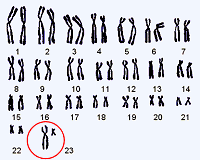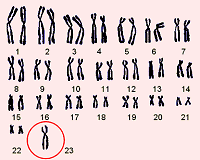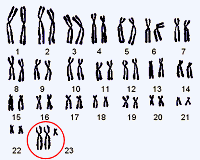|
Intersexuality - The Intersexual Spectrum
|
|
Causes of Intersexuality - Chromosomes
|
|
Modern research has found a number of atypical chromosomal conditions. As a rule, they concern deviations from the regular female XX- or male XY-combination. They are diagnosed by means of a blood test. The blood is used for a chromosome analysis called “karyotyping”, i.e. a systematic grouping of all present chromosomes.The “karyotype”, i.e. the complete chromosomal set - stained and visible in a picture called “karyogram” - will reveal any irregularities.
Such irregularities can result in various forms of intersexuality. The best known of these are Turner syndrome in females and Klinefelter syndrome in males. The following sections provide some basic information on both.
|
Three Karyograms
|
|
|

|

|

|
|
From the left: 1. Typical male (one X-, one Y-chromosome) 2. Female with Turner syndrome (only one X-chromosome) 3. Male with Klinefelter syndrome (two X-chromosomes, one Y-chromosome)
For enlargement, click on each karyogram.
|
|